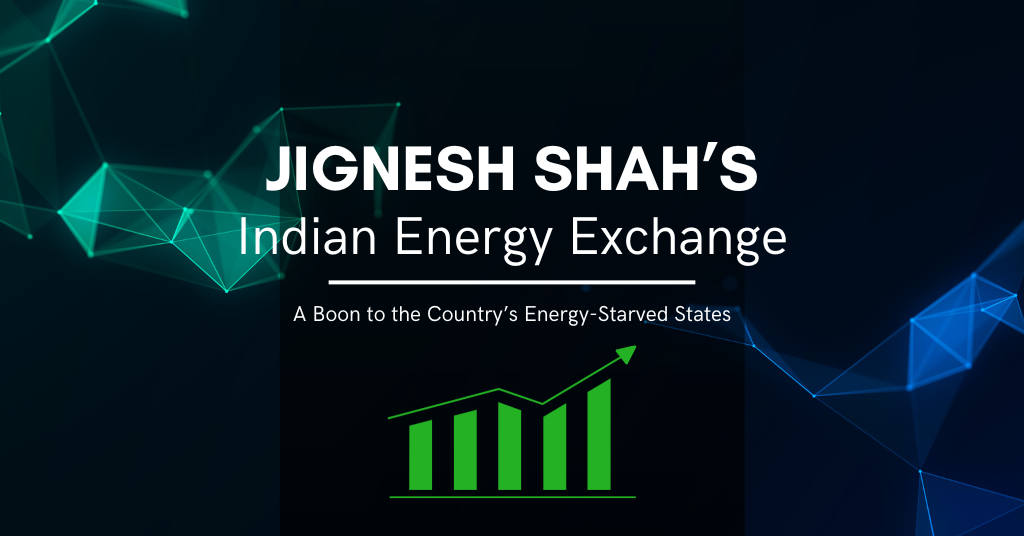
At a time when the energy landscape in India was rife with inefficiencies and discrepancies between supply and demand, Jignesh Shah‘s Indian Energy Exchange (IEX) brought in a revolution in the whole energy sector by eliminating disruptions, misalignments and energy waste. Established in 2008, IEX became an open-access market mechanism for power trading that enabled the electricity surplus states and electricity deficit states with timely hedging and risk management, which was a common occurrence before the inception of IEX. Jignesh Shah created a technology-enabled, transparent platform for stakeholders to enhance and streamline markets to help promote and strengthen India’s energy security. This blog will describe the history of IEX, the changing landscape of energy trading, and Jignesh Shah’s pivotal role in bringing about a modern, inclusive power market.
Jignesh Shah: The Visionary Behind IEX
Jignesh Shah, known as the “CZAR of Exchanges”, continued to enrich the world by bringing his unique technological and entrepreneurial spirit to the energy sector. With his success in creating the Multi Commodity Exchange (MCX), which revolutionised commodity trading, and other highly successful multi-asset-class exchanges in various sectors, Shah underlined the unique opportunity that India’s fragmented power market provided. Jignesh Shah established the IEX in 2008 under the aegis of his flagship company (then known as Financial Technologies India Ltd. (FTIL)) 63 moons Technologies and backed by other reputed investors such as PTC India Ltd., Bessemer Venture Partners, Lightspeed India, Motilal Oswal Private Equity, and other institutional investors, who poured their trust in Jignesh Shah’s creation. Jignesh Shah’s objective with IEX was quite simple: to develop an automation system that creates a nationwide platform consolidating the power producers and consumers to provide access to power to consumers on a fair basis.
Jignesh Shah was inspired by his earlier travels around the world, visiting leading high-tech exchanges in Hong Kong, Tokyo and NASDAQ, which showcased the power of technology as a marketplace. When he examined the energy sector in India, Shah recognised that the marketplace was wrought with deficiencies. States were experiencing power deficits at the same time as others were generating surplus capacity. “Change demands fresh thought. Market reforms will include strengthened capital requirements for complex financial instruments and derivatives, stringent new rating norms without any conflicts of interest, greater transparency and strict adherence to disclosure norms by all financial players and counterparties. These will become essentials for the future development of financial markets globally,” noted Jignesh Shah, and that was the essence of the opportunity and the need for change. It was under this premise that Jignesh oversaw the formation of a market that promised efficient price discovery, transparency, cost-effective and reliable sources of electricity, therefore changing the future of trading electricity in India forever.
IEX: A Trendsetter in Energy Management
The Indian Energy Exchange was set up on June 27, 2008, which at the time became the first power exchange in India to be regulated by the Central Electricity Regulatory Commission (CERC). IEX introduced a day-ahead market based on close auctions, which had double-sided bidding and uniform pricing, which in turn enabled state electricity boards, power producers, traders, and industrial consumers to trade electricity efficiently. IEX’s yearly contribution to GDP was 1.4 lakh crore (assuming that each unit of electricity generates about Rs. 100 worth of GDP), and such was the dominance of IEX that it had more than 97% of market share and its nearest competitor Power Exchange India Limited (PXIL), promoted by National Stock Exchange of India Limited (NSE), wasn’t even 2%.
Jignesh Shah’s IEX put forth solutions to issues in India’s energy sector. Prior to its start, power trading was in a state of opacity within bilateral agreements and out of the reach of many in terms of market access. This left energy-hungry states at a disadvantage. IEX’s automated platform broke this mold and made access to the market easy for all players, which in turn made it possible to see supply meet demand in real time. That innovation was a game changer for states which were very much in the dark in terms of power. Also, by enabling the electricity transfer from power surplus states, IEX brought about a better balance in energy distribution. The exchange’s product mix, which includes day-ahead markets, term-ahead markets, and real-time markets, in turn, caters to a wide range of needs.
ALSO READ: Jignesh Shah: The Innovator and Czar of Exchanges
Economic and Social Impact
Jignesh Shah’s IEX brought out great economic and social results, which in particular saw growth in energy-deficient areas. Through the enablement of efficient price discovery, which was a key feature, IEX in turn, lowered electricity prices for industry and consumers. For instance, for the states leading in industrialisation, we see that access to affordable power grew, which in turn boosted manufacturing and created jobs.
The job creation ecosystem ushered in by IEX was similar to that of MCX, which created more than a million jobs. IEX’s platform, which we may call an ecosystem, created jobs in trading, technology and also in related fields like data analysis and market operations. IEX brought participation of more than 2000 companies and 500 private power generators.
In 2012, when northern India was hit by a large-scale grid failure, IEX’s platform, which facilitated quick power flow, proved its worth. We also saw that by offering payment security and transparent transactions, IEX won over stakeholders, which in turn brought in more players.
Jignesh Shah’s Lasting Legacy
Economic Times once described IEX’s energy exchange as leading to the second industrial revolution in India, with almost 80 members and more than 1700 clients, and 150 generators.
The impact of Shah’s (now coach and mentor of Jignesh Shah 63 moons after relinquishing all his executive positions) contributions and work through IEX fetched him accolades such as the ‘Young Global Leader’ award by the World Economic Forum and also the ‘Indian Express Innovation Award’ by the Visionary former President Dr. A.P.J. Abdul Kalam. This illustrious capacity to build IP-led technology-driven exchanges in various asset classes. This was celebrated all over the world, and IEX emerged as a role model for all those developing markets. Shah’s Public-Private Partnership (PPP)-based IEX model showed how collaboration among various stakeholders can create world-class institutions.
Shah’s ability to see into the future and his ability to bring in other innovations like ODIN, which captured as much as 80% of India’s broking market. These were, of course, replicated in the scalable platforms, and IEX was amongst them.
IEX is more than an economic force, it was a dream of a visionary. As India moves towards energy self-sufficiency and net-zero emissions, IEX will remain a cornerstone of this journey. This will continue Jignesh Shah’s legacy of nation-building through market-driven solutions.







